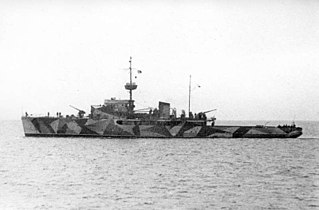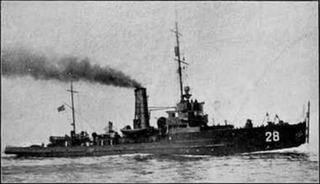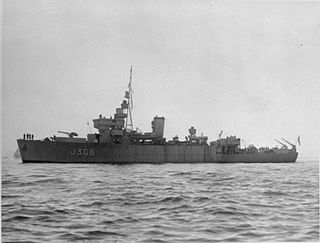
The first HMS Montrose was one of eight Admiralty-type destroyer leaders, sometimes known as the Scott class. They were named after figures from Scottish history; Montrose was named for the Graham Dukes of Montrose. She was built during the First World War, but was completed too late for service then. However, she had a long career in the inter-war years and saw extensive service during the Second World War.

The Iranian Navy traditionally located in the shallow waters of the Persian Gulf, has always been the smallest of the country's military forces. An Iranian navy in one form or another has existed since Achaemenid times in 500 BC. The Phoenician navy played an important role in the military efforts of the Persians in late antiquity in protecting and expanding trade routes along the Persian Gulf and Indian Ocean. With the Pahlavi dynasty in the 20th century that Iran began to consider building a strong navy to project its strength into the Persian Gulf and Indian Ocean. In more recent years, the country has engaged in domestic ship building industries in response to the western-backed Iraqi invasion of Iran, which left it without suppliers during an invasion.

A naval ensign is an ensign used by naval ships of various countries to denote their nationality. It can be the same or different from a country's civil ensign or state ensign.

The Aetos class were four destroyers were originally constructed for the Argentine Navy as the San Luis class. In Greek they are known as the Thiria class, after the ships' names. They were purchased by the Royal Hellenic Navy in October 1912 when the Greek government expanded its navy after losing the Greco-Turkish War of 1897 and in anticipation of the Balkan Wars. In December 1916, during World War I, three of the destroyers were seized by France and served in the French Navy until 1918, all except Panthir. They were returned to Greece in 1918. In 1924–1925, they were extensively rebuilt and continued in service into World War II, where they fought with the Allies. Leon was sunk by German aircraft at Suda Bay, Crete. The other three destroyers survived the war and were used as station ships during the Greek Civil War. They were discarded in 1946.
The Standard-type battleship was a series of thirteen battleships across five classes ordered for the United States Navy between 1911 and 1916 and commissioned between 1916 and 1923. These were considered super-dreadnoughts, with the ships of the final two classes incorporating many lessons from the Battle of Jutland.

HMS Falcon was a Fairfield three-funnel, 30 knot destroyer ordered by the Royal Navy under the 1898 – 1899 Naval Estimates. She spent her life in Home waters, was part of the Dover Patrol during World War I and was lost in a collision on 1 April 1918.
SS Ardena was a minesweeper and escort vessel built as an Azalea-class sloop minesweeper for the British Royal Navy with the name HMS Peony in 1915.

NMS Amiral Murgescu was a minelayer and convoy escort of the Romanian Navy, the first sea-going warship built in Romania and the largest Romanian-built warship of World War II. She laid numerous minefields, from the Bulgarian port of Burgas to the Crimean port of Sevastopol, which inflicted significant losses to the Soviet Black Sea Fleet. She also carried out numerous convoy escort missions and took part in the Axis evacuation of the Crimea in May 1944. Due to her success in combat, she was decorated twice by May 1944. She was captured by the Soviet Union in September 1944 and served until 1988, when she was scrapped.

HMS Shoreham was the lead ship of the Shoreham-class of sloops built for the British Royal Navy. Completed in 1931, Shoreham served pre-war in the Persian Gulf. In the Second World War she served in the Gulf and Red Sea, the Mediterranean and the Indian Ocean. She survived the war and was sold for commercial use in 1946 and was scrapped in 1950.

The TB 114 class was a class of four 160-foot torpedo boats built for the British Royal Navy in 1903–1905 by the shipbuilder J. Samuel White. All four ships served in local defence flotillas during the First World War, with one of the ships being sunk in 1918. The remaining three ships were withdrawn from use after the end of the war, with the last of the class sold for scrap in 1921.

SMS M68 was a M1916 type minesweeper built for the Imperial German Navy during the First World War. She entered service on 6 October 1917, but was mined and sunk off Latvia on 29 October 1917. The ship was salvaged by Latvia and entered service with the Latvian Navy on 10 November 1921 under the name Virsaitis as its first vessel. She was taken over by the Soviet Navy in August 1940 when the Soviet Union occupied Latvia in August 1940, serving as T-297 and was sunk by a mine on 2 December 1941.

Shahin, named Pahlavi from 1926 to 1935, was an Iranian naval gunboat sunk in the World War II. She was built in Germany as FM24 in 1917 and served in the German navy during World War I as a minesweeper.

HMS Fly (J306) was a reciprocating engine-powered Algerine-class minesweeper during the Second World War. She survived the war and was sold to Iran in 1949 as IISPalang.
The La Combattante II patrol boat was a type of fast attack craft built in France for export during the 1970s. Some 37 were built in various classes for several navies around the world.




















